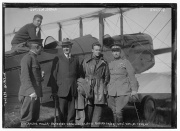Early Life↑
William “Billy” Mitchell (1879-1936) was born in Nice, France, the grandson of one of the wealthiest men in the American Midwest, who built his fortune in banking and railroads. He grew up in Milwaukee and attended what is now known as George Washington University before joining the U.S. Signal Corps during the Spanish-American War. Eventually becoming enamored with flight, he took flying lessons at his own expense. In 1912, he became the youngest member of the Army General Staff at the age of 33, and by 1916 had risen to Chief of the Air Service of the First Army.
Saint-Mihiel Offensive↑
The Saint-Mihiel salient was a narrow bulge in the German lines on the Western Front, protruding around the French town of Saint-Mihiel and just across the Meuse River southeast of Verdun. The Germans had stubbornly held it since the war’s beginning as a buffer to protect critical rail and supply lines at Metz. General John “Black Jack” Pershing (1860-1948), the American Expeditionary Forces commander who so far had parceled out his units to support European armies, now had a major attack under his control. More than 600,000 U.S. and French soldiers, 3,010 artillery pieces, and 267 tanks were massed on the northern and southern edges of the salient to squeeze out the Germans inside the bulge beginning 12 September 1918.
Massive Airpower Display↑
Mitchell had assembled the largest concentration of aircraft ever put together for one battle: 1,476 American, French, British, and Italian warplanes. The Germans, he calculated, could launch nearly 2,000 aircraft against the allies by day three of the attack. Mitchell proposed a bold plan no air commander had ever attempted—a massive first strike behind enemy lines to knock out German supply points and air facilities. Up to that point, Pershing’s ground commanders had little idea how to use airpower as an offensive weapon in war, seeing it mostly as a tool for reconnaissance. Mitchell hoped heavy blows in the beginning would stagger the enemy, giving the Allies control of the skies for the first few days until the Germans recovered and counterattacked.
A Short Offensive↑
Flying over the Saint-Mihiel salient two days before the offensive’s start, Mitchell realized the Germans had no intention of holding it. He could see some enemy units preparing to move to the rear. “The battle of Saint-Mihiel was really over on the first day,” Mitchell wrote in his book, Memoirs of World War I. Heavy rains and high winds limited the massive strike he planned at the outset, but some of Mitchell’s pilots managed to strafe enemy troops and bomb supply dumps in the German rear. By day three, the Germans sent planes over Allied lines, but Mitchell’s strategy of overwhelming force kept most enemy aircraft pinned down or defending rear echelons.
Meuse-Argonne Offensive↑
The final American offensive, to punch through German lines on the Western Front between the Meuse River and the Argonne Forest, proved more difficult for Pershing’s ground soldiers and Mitchell’s aviators. On 26 September 1918 over one million Americans were thrown into the costly battle, which took six and half weeks for Pershing to win. The weather stayed miserable. This time the Germans put more planes into the fight. But the strategy of overwhelming air power again succeeded in helping block German advances.
Airpower’s Role in WWI↑
Mitchell’s pilots dropped 138 tons of bombs on 150 targets during the war and shot down twice as many German planes as the Germans did of theirs. But the airplane was not the decisive weapon of the war. That honor belonged to the artillery. Aerial bombing did more psychological than actual damage; troops felt helpless when the flying machines dumped ordnance on them. Pershing, however, left Europe pleased with his pilots.
After the war, Mitchell became a worldwide celebrity when in 1921 his bi-planes attacked a surplus German dreadnought and sent it to the bottom of the ocean, proving that aircraft could sink a battleship. Opinionated and abrasive, Mitchell was court-martialed in 1925 for insubordination after he publicly criticized the army and navy for neglecting airpower. Even so, Mitchell, who planted the seeds for what is now America’s global airpower, is regarded by many as the father of the United States Air Force.
Douglas C. Waller, Independent scholar
Reviewed by external referees on behalf of the General Editors
Selected Bibliography
- Coffman, Edward M.: The war to end all wars. The American military experience in World War I, Lexington 1998: University Press of Kentucky.
- Davis, Burke: The Billy Mitchell affair, New York 1967: Random House.
- Hurley, Alfred F.: Billy Mitchell. Crusader for air power, New York 1964: F. Watts.
- Kennett, Lee B.: The first air war, 1914-1918, New York 1999: Free Press.
- Mitchell, William: Memoirs of World War I, New York 1960: Random House.
- Waller, Douglas C.: A question of loyalty: Gen. Billy Mitchell and the court-martial that gripped the nation, New York 2004: HarperCollins.








